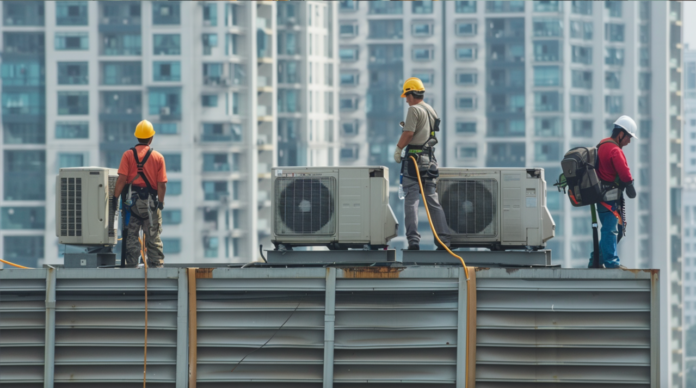When buying a car, you might look at how many miles per gallon the car can achieve when comparing which car is more efficient. This is an indication of its ability to convert fuel into a certain distance traveled. A similar ratio in the HVAC industry is used to indicate how efficient an air conditioner or heat pump is at using electricity to produce BTU’s.
Beginning on January 1, 2023, the US Department of Energy (DOE) has changed to a new rating system where different regions of the United States are divided up. There are now Northern and Southern regions with varying efficiency ratios. Any air conditioners installed starting in 2023 and after in the Southwest and Southeast regions of the United States must meet the new SEER2 energy efficiency standard.

Regions matter because different standards are based on the climate needs of customers living in the North, Southeast, and Southwest regions. People in southern climates, where air conditioners are used more frequently, require more energy-efficient systems. Therefore, depending on your geographical region and HVAC needs, split system air conditioners, heat pumps, and single-package systems may have varying efficiency standards.
Energy Efficiency Ratio (EER)
The Energy Efficiency Ratio (EER) measures the efficiency of an air conditioning system or heat pump. It indicates how effectively the unit converts electrical energy into cooling output. Specifically, EER represents the ratio of the cooling capacity (in British Thermal Units per hour, or BTU/h) to the power input (in watts) at a given operating condition.
EER Calculation
EER = Cooling Capacity (BTU/h) / Power Input (W)
EER is typically measured under specific conditions: an outdoor temperature of 95°F, an indoor temperature of 80°F, and 50% relative humidity. This standardization allows for a direct comparison of different units under the same conditions.
Seasonal Energy Efficiency Ratio (SEER)
The Seasonal Energy Efficiency Ratio (SEER) measures the overall energy efficiency of an air conditioning system or heat pump over an entire cooling season. Unlike the Energy Efficiency Ratio (EER), which is calculated at a single operating condition, SEE considers the variations in temperature and cooling demand that occur throughout the season. It represents the ratio of the total cooling output (in BTUs) to the total electrical energy input (in watt-hours) over the cooling season.
SEER Calculation
SEER = Total Cooling output over a Season (BTU) / Total Electric Energy Input over a Season (Wh)
SEER ratings provide a standardized way to compare the energy efficiency of different air conditioning units and heat pumps, considering the varying cooling demands throughout the cooling season. This helps consumers and professionals make informed decisions when selecting HVAC equipment for energy efficiency and cost savings.
Heating Seasonal Performance Factor (HSPF)
The Heating Seasonal Performance Factor (HSPF) measures the efficiency of heat pumps in heating mode over an entire heating season. It represents the ratio of the total heating output (in British Thermal Units, or BTUs) to the total electrical energy input (in watt-hours) during the heating season. HSPF provides an indication of how efficiently a heat pump converts electricity into heat over a range of conditions and temperatures experienced throughout the heating season.
HSPF Calculation
HSPF = Total Heating Output (BTU) / Total Electric Energy Input (Wh)
HSPF provides a comprehensive measure of a heat pump’s heating efficiency over a typical heating season, helping consumers and professionals make informed decisions about equipment that offers better energy savings and performance in various climates.
The new SEER2 Standards
The calculation for SEER2, like the original SEER, is designed to measure the overall energy efficiency of an air conditioning system or heat pump over a cooling season. While the fundamental formula remains similar, SEER2 incorporates updated testing conditions and procedures to better reflect real-world performance.
SEER2 Calculation
SEER2 = Total Cooling Output (BTU) / Total Electric Energy Input (Wh)
Key Differences in SEER2 vs SEER Calculation:
1. Updated Testing Conditions
SEER2 includes more representative testing conditions that reflect a wider range of operating environments and load profiles, considering part-load and variable load conditions more accurately.
2. Improved Measurement Techniques
SEER2 employs updated measurement techniques to account for variations in system performance, cycling losses, and other factors that impact efficiency under real-world conditions.
3. Standardized Load Profiles
SEER2 uses standardized load profiles that mimic the fluctuating cooling demands typical of an entire cooling season, offering a more comprehensive assessment of system efficiency.
Example Calculation
If an air conditioning system provides 60,000 BTUs of cooling over a season and consumes 4,000 watt-hours (Wh) of electricity during that time, the SEER2 would be calculated as follows:
SEER2 = 60,000 BTU / 4,000 = 15
Application
Regulatory Standards: SEER2 is used to set minimum energy efficiency standards for new HVAC systems, ensuring they meet contemporary performance requirements.
Product Comparison: Consumers and professionals can use SEER2 ratings to compare the efficiency of different air conditioning units and heat pumps, aiding in the selection of more energy-efficient models.
Energy Savings: Higher SEER2 ratings indicate better energy efficiency, which translates to lower energy consumption and cost savings over the cooling season.
By incorporating more realistic testing conditions, SEER2 provides a more accurate measure of an HVAC system’s seasonal energy efficiency, helping to promote the use of systems that are more efficient and environmentally friendly.
Uses of EER, SEER and HSPF
Performance Assessment: These calculations offer a standardized way to compare the efficiency of different air conditioners or heat pumps. A higher value indicates better energy efficiency.
Energy Cost Savings: HVAC Equipment with higher ratings use less electricity to produce the same amount of heating or cooling, leading to lower energy bills.
Environmental Impact: More efficient air conditioners or heat pumps reduce overall energy consumption and greenhouse gas emissions, contributing to environmental sustainability.
Regulatory Compliance: In many regions, building codes and energy standards specify minimum efficiency ratio requirements for air conditioners and heat pumps. Compliance with these regulations ensures that installations meet energy efficiency standards.







